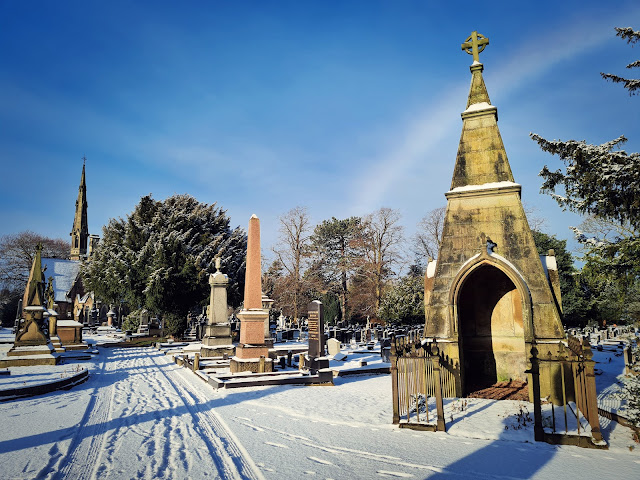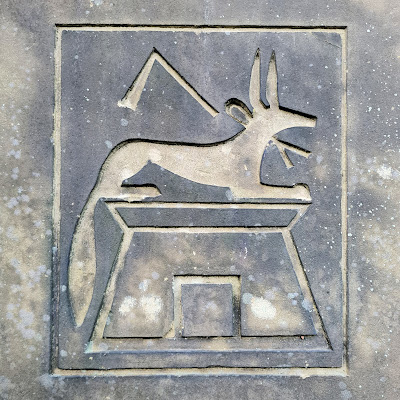“Wasn’t Ian Curtis from Macclesfield?” I suddenly remembered. My brother takes his time to answer.
“Buried there,” he eventually says, rather tersely, knowing of my interest in such things, before adding “the cemetery is near the hospital.”
At some point during one of the two nights I spent sitting by my father’s hospital bed, I recalled this conversation and checked where the singer’s grave was. The cemetery and crematorium were in Prestbury Road, a ten-minute stroll away from the hospital. As day dawned after my second sleepless night spent in a chair in dad’s hot and stuffy side room, when I went to his window to look out at the view of brick walls, service pipes and rubbish bins, I was surprised to see that it had been snowing. The snow must have been silently falling for hours as there were a good couple of inches on the ground. When my sister came to join me an hour or two later, she encouraged me to get some fresh air. Forty minutes was enough time to walk to the cemetery, stroll round, find the grave (helpfully marked on google maps), take a few photos and walk back to the hospital. The snow-covered cemetery and Curtis’ grave reminded me of Kevin Cummin’s famous photos of Joy Division taken 45 years ago, in January 1979, standing on the Princess Parkway in Hulme. Time collapsed for me and I found myself vividly reliving my own memories of the time and of the band.
Ian killed himself on the night of Saturday/Sunday 17/18 May 1980, though the 18th is usually given as his date of death. I found out the following day, the Monday, probably around 10.15pm. I was about to leave the student bar at my college when my friend Joe walked in. A bespectacled Cornishman in a worn leather jacket and crumpled cords, he looked like he was in shock and said that he needed a drink. Unusually he ordered a neat whisky. “I was listening to John Peel,” he told me, “Ian Curtis is dead.” It was my turn to be thunderstruck. We had been to the second of the three gigs Joy Division played at the Moonlight Club the previous month and the Rainbow in Finsbury Park in November when they supported the Buzzcocks. The band were everywhere – they were on the cusp of the big time, the music papers raved about them, John Peel, if no one else, played tracks from Unknown Pleasures and the various singles and EP’s every other night on his Radio 1 show and they had done their first TV appearances. Their new album was already recorded and due out in the summer. We were obsessed by two bands, The Fall and Joy Division; Joe had introduced me to both. We caught every gig we could, we bought the records, read the reviews and interviews in the music press and, about Joy Division, we gossiped because one of the girls at the college was going out with a music journalist and he knew the band well enough to go backstage and hang out with them when they were in London. He told us things about the band that weren’t common knowledge. That Ian had a wife and kid ‘up north’ and that he had a glamourous ‘French’ girlfriend (in reality she was Belgian and her name was Annik Honoré). There were hints of his marital problems. We knew about his epilepsy. We knew next to nothing but felt like we knew a lot. But now Ian Curtis was dead and we didn’t understand how or why he had died. John Peel’s announcement at the start of his show had been brief, apologising for being the bearer of bad news he told his audience that Ian Curtis, the singer of Joy Division had died and he had no further details. After saying that his thoughts were with the family and friends he played ‘New Dawn Fades’ and when the track finished my stunned friend came to knock on my door to see if I had heard and, when I wasn’t in my room, he made his way to the bar. After much discussion we decided that it must have been Ian’s epilepsy that had killed him.
 |
| The last known photo of Ian Curtis, a photo booth passport shot, taken for the American visa he needed for the band's forthcoming US tour |
It
was our journalist acquaintance who first told us, a couple of days later, that
he had committed suicide, that he had hung himself in the kitchen of his house.
We found ourselves in shock all over again. Premature deaths in the music
business weren’t unknown but they were the usually the result of an accident
and drugs were generally involved somewhere. We didn’t know of any other case
where someone has actually killed themselves. Someone on the brink of success,
with fans that idolised him, a wife, a child, a girlfriend, who journalists
called a genius, killed themselves. It just did not make any sense. The
mythmaking began immediately; hagiographic accounts of the tortured, sensitive
genius, too good for this world filled the music press. Just a couple of weeks
later Dave McCulloch in Sounds wrote “his was a poetically beautiful death. It
was no cheap r’n’r death….Ian Curtis belonged to the real world: the bleak and
industrial pyre you made for him is now your own pyre, your own guilt, your own
stupidity, your own way of evading the simple truths…That man cared for you,
that man died for you, that man saw the madness in your area.” Leaving aside
the irony that the final lines in McCulloch’s angry eulogy were lifted from
songs by The Fall, what is interesting is how the writer seems to somehow blame
the reader for Curtis’ death. The singer has become a martyr to and for his
listeners!
As always happens following the death of a noteworthy musician within a few weeks Joy Divisions next single ‘Love will tear us apart’ was in the charts. It only reached number 13 but that was still incredible for an Indie band. The second album ‘Closer’ came out a month later and reached number 6 in the album charts. For the whole of that year the music press seemed to speak of little else other than Joy Division and Ian Curtis’ death. I found it all rather harrowing. I had been struggling with my own mental health issues since I had left school in 1978. I had spent the first 8 months of 1979 attending a psychiatric day hospital and had made multiple, incompetent, suicide attempts. At college I gritted my teeth and marched miserably through each day, somehow hoping that things would improve for me. Ian Curtis’ suicide was a horribly bleak reminder that life really probably was not worth living. I found myself poring over the lyrics to the later songs and identifying completely with Ian’s despair, like this from that otherwise quite chipper track ‘Isolation’;
Mother
I tried please believe me
I’m
doing the best that I can
I’m
ashamed of the things I’ve been put through
I’m
ashamed of the person I am
I became so obsessed that at the end of the year I wrote a long letter to the NME explaining exactly why Ian had killed himself. Much to my amazement they published the letter; thankfully I have lost my copy and that edition of the paper has never been digitised as my explanation was no doubt, hopelessly callow. My heart felt theories about Ian’s reasons for killing himself were, as these things often are, an attempt to understand my own feelings. My identification with the singer’s emotions, as expressed in his lyrics, was so complete that dissecting them was dissecting myself. From Ian’s suicide I moved onto others; Sylvia Plath and John Berryman in particular. My obsession with Ian’s death, reading Al Alvarez’s The Savage God and talking to my friends were the only forms of therapy I had. Psychiatrists checked in on me, assessed my symptoms and adjusted my medications but there were no other methods available to help me deal with or understand my crippling depression. It took me quite a while, the best part of three years perhaps, but I eventually managed to dig my way out of the hole I was burying myself in. I learned to cope with myself, with my emotions and with the messiness of life. My friends, all just kids themselves at the time, helped me enormously. But Ian Cutis helped me too, and I will be forever grateful to him for that, and for the music, which I still listen to.



































